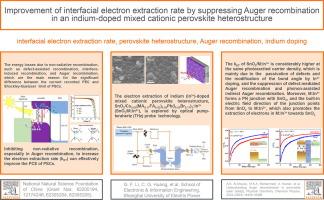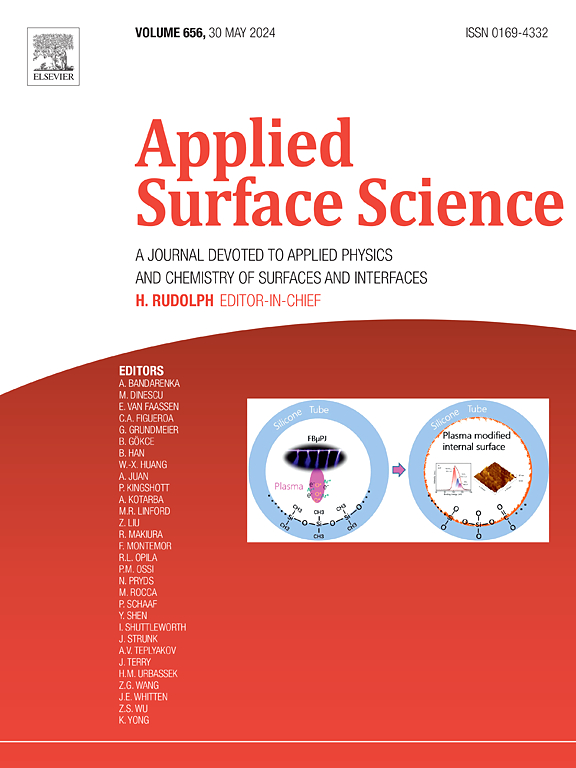Improvement of interfacial electron extraction efficiency by suppressing Auger recombination in an indium-doped mixed cationic perovskite heterostructure
IF 6.3
2区 材料科学
Q2 CHEMISTRY, PHYSICAL
引用次数: 0
Abstract
The electron extraction of indium (In3+)-doped mixed cationic perovskite heterostructure, SnO2/Cs0.05(MA0.17FA0.83)0.95Pb(I0.83Br0.17)3:In3+ (SnO2/M:In3+), is explored by optical pump-terahertz (THz) probe technology. The difference of the conductivity maxima (Δσdm) of M and SnO2/M is used to calculate the electron extraction efficiency of SnO2/M with photoexcited carrier density of 2.66 × 1018 ∼ 1.33 × 1019 cm−3, which are 33.14 %, 32.01 %, 31.17 %, −3.73 %, and –23.66 %, respectively. The negative electron extraction efficiency of SnO2/M with photoexcited carrier density from 1.06 × 1018 to 1.33 × 1019 cm−3 is caused by the extraction of electrons from SnO2 into M. For SnO2/M:In3+, electron extraction efficiencies are 51.76 %, 52.68 %, 49.51 %, 48.03.% and 48.03 % with photoexcited carrier density increased from 2.66 × 1018 cm−3 to1.33 × 1019 cm−3, respectively, which are all positive and about 20 % higher than that of SnO2/M, related to the suppression of Auger recombination and super-injection phenomenon by In3+ doping. The insights of this investigation provide important experimental data and theoretical basis for design and production of efficient perovskite solar cells.

通过抑制掺铟混合阳离子包晶异质结构中的奥杰尔重组提高界面电子萃取效率
利用光泵-太赫兹(THz)探针技术探讨了掺杂铟(In3+)的混合阳离子包晶异质结构 SnO2/Cs0.05(MA0.17FA0.83)0.95Pb(I0.83Br0.17)3:In3+(SnO2/M:In3+)的电子萃取。在光激发载流子密度为 2.66 × 1018 ∼ 1.33 × 1019 cm-3 时,利用 M 和 SnO2/M 的最大电导率差值(Δσdm)计算 SnO2/M 的电子萃取效率,其值分别为 33.14 %、32.01 %、31.17 %、-3.73 % 和 -23.66 %。对于 SnO2/M:In3+,光激发载流子密度从 1.06 × 1018 cm-3 到 1.33 × 1019 cm-3 时的电子萃取效率分别为 51.76 %、52.68 %、49.51 %、48.03 % 和 48.03 %。随着光激发载流子密度从 2.66 × 1018 cm-3 增加到 1.33 × 1019 cm-3,电子萃取效率分别为 51.76 %、52.68 %、49.51 %、48.03 % 和 48.03 %,均为正值,比 SnO2/M 的电子萃取效率高约 20%,这与 In3+ 掺杂抑制了奥杰尔重组和超注入现象有关。这项研究的启示为设计和生产高效的过氧化物太阳能电池提供了重要的实验数据和理论依据。
本文章由计算机程序翻译,如有差异,请以英文原文为准。
求助全文
约1分钟内获得全文
求助全文
来源期刊

Applied Surface Science
工程技术-材料科学:膜
CiteScore
12.50
自引率
7.50%
发文量
3393
审稿时长
67 days
期刊介绍:
Applied Surface Science covers topics contributing to a better understanding of surfaces, interfaces, nanostructures and their applications. The journal is concerned with scientific research on the atomic and molecular level of material properties determined with specific surface analytical techniques and/or computational methods, as well as the processing of such structures.
 求助内容:
求助内容: 应助结果提醒方式:
应助结果提醒方式:


